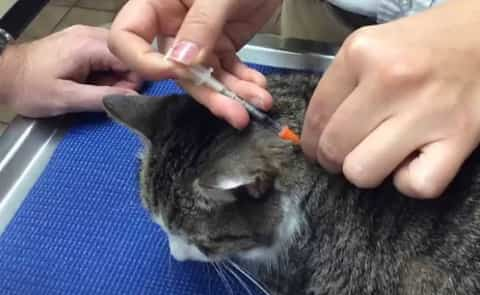Diabetes in cats is an endocrine disease that is caused by a deficiency in the production of insulin by the pancreas and has become more and more common in recent years. Older and overweight cats are statistically more likely to develop diabetes. Cats are also more likely to have a diagnosis of diabetes than dogs.
Signs and Symptoms of Feline Diabetes
If your feline friend is acting a bit out of the ordinary, it could be more than just a mood swing. Diabetes is surprisingly common in cats, and early diagnosis is crucial.
Symptoms of diabetes in cats range from increased thirst and urination, to unexplained weight loss, despite increased appetite. Your cat may also display an unsteady gait or weakness, particularly in the hind legs. Enlarged liver, cloudy eyes, or chronic infections may also indicate diabetes.
How to recognize diabetes in cats and when to consult a vet
Any changes in your cat’s behavior or physical appearance should warrant a consultation with a vet. If your pet shows chronic symptoms such as frequent urination, constant thirst or recurrent infections, it’s time to consult the vet immediately for potential diabetes diagnosis. Remember early detection can significantly improve prognosis and quality of life for your pet.

Diagnosing Diabetes in Cats
Diagnosing diabetes in cats can be a matter of steady observance and precise medical scrutiny. Your vigilant eye, paired with your veterinarian’s expertise, can catch the disease early and help manage it effectively.
Tests and procedures used to diagnose feline diabetes
Blood and urine tests: Two key tests help detect feline diabetes – blood tests and urine tests. They measure the glucose concentration levels, which if found in high amounts can indicate feline diabetes.
Understanding blood glucose levels and other diagnostic markers
Critical Analyses: Establishing an understanding of your cat’s blood glucose levels is a crucial aspect of the diagnosis. The presence of glucose in urine, known as glycosuria, is another diagnostic marker of diabetes in cats. With these markers, veterinary professionals can accurately diagnose and monitor the condition.
Treatment Options for Feline Diabetes
Diabetes is a serious disease that affects not only humans but also our four legged companions. Cats can get diabetes, and like humans, they need to have their blood sugar levels managed to sustain their health.
Managing diabetes in cats through diet and exercise
Diet and Exercise: The first line of defence against diabetes in cats is, surprisingly, a good diet and an active lifestyle. Feeding your cat high protein, low carbohydrate food, and ensuring they get regular exercise can help maintain their glucose levels.
Insulin therapy and other medications for diabetic cats
Medication: Insulin Therapy is another treatment option. It involves giving insulin injections to your pet, which helps regulate their blood sugar. Other medications may also be prescribed by your vet depending on the specific needs of your pet. Always consult with a professional for personalized advice.
Monitoring and Managing Blood Glucose Levels
Cats diagnosed with Diabetes require careful management, including a strong emphasis on monitoring their blood glucose levels.
Importance of monitoring blood glucose levels in diabetic cats
Maintain Optimal Levels: Regularly checking your cat’s blood glucose levels is crucial for managing their diabetes. This aids in ensuring optimal sugar levels are maintained for your furry friend, avoiding severe health complications such as hypoglycemia.
Tools and techniques for tracking glucose levels at home
Glucose monitors: By investing in a reliable pet-specific glucose meter and learning how to use it at home, you can gain the ability to quickly and effectively monitor your cat’s blood sugar levels. These tools, along with a consistent tracking routine, van expedite the detection of potential health threats, leading to more prompt and effective treatment.
Feline Diabetes Diet
Similar to human diabetes, managing feline diabetes means dealing with high blood sugar levels. An essential aspect of this battle is your pet cat’s diet.
Choosing the right diet for diabetic cats
Feeding Specifics: By providing your cat with a diet higher in protein and low in carbohydrates, you may achieve better blood sugar management. Choose a well-balanced, nutritious cat food that meets the dietary needs of diabetic cats.
Key nutrients to consider and dietary guidelines for managing diabetes
- Fiber: Some studies suggest dietary fiber assists in controlling blood glucose.
- High Protein: Promotes better insulin response.
- Frequent Meals: Small, frequent meals can also help stabilize your cat’s sugar levels.
Lifestyle Changes for Diabetic Cats
Diabetes is a common health issue for cats. Making specific lifestyle alterations can help to manage this enduring ailment.
Exercise, weight management, and lifestyle modifications for diabetic cats
Achieving Balance: Striking a balance between exercise and diet plays a vital role in managing diabetes in cats. Increased physical activity and a low-carb, high-protein diet can contribute to weight loss, which can help regulate sugar in the bloodstream.
Creating a comfortable and stress-free environment for diabetic cats
Stress Management: Stress can significantly affect the glucose levels in diabetic cats. Therefore, creating a relaxed ambiance by providing comfortable living conditions and reducing triggering factors is crucial for their wellbeing. Regular vet check-ups and avoiding abrupt changes in their routine are also essential management methods.###





